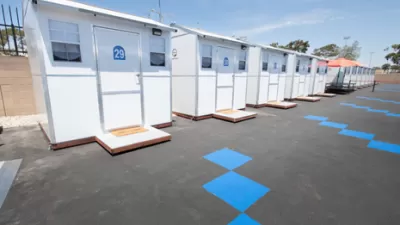Cheap construction materials, crowdfunding, and volunteer construction crews have produced villages of tiny homes as a place for the homeless to find shelter in every corner of the United States. What does it take for such homes to work?
Brendan O'Brien reports on a growing village of tiny homes in Madison, Wisconsin, originally built by the Occupy Madison group to shelter the homeless. The Madison group is one example of a few around the country—including in New York, Texas, and Washington—where tiny homes are providing shelter for the homeless.
In Madison, the hope is to eventually build 30 homes. The materials for each home cost about $5,000—so far one home is complete and two more are under construction. According to O'Brien "In Newfield, New York, organizers plan 14 to 18 tiny houses on private land with private donations. In Austin, Texas, the plan is to build a village of tiny houses and small shelters for 200 people on 27 acres."
O'Brien quotes Steve Berg of the National Alliance to End Homelessness in describing how programs like these can help the homeless find permanent shelter: "The essential element is a stable residence and any kind of a network of supports," says Berg.
As pointed out by previous coverage of the use of tiny houses to shelter the homeless, zoning and building codes often prevent the construction of tiny-houses.
FULL STORY: Tiny houses a way off the streets for Wisconsin homeless

Alabama: Trump Terminates Settlements for Black Communities Harmed By Raw Sewage
Trump deemed the landmark civil rights agreement “illegal DEI and environmental justice policy.”

Planetizen Federal Action Tracker
A weekly monitor of how Trump’s orders and actions are impacting planners and planning in America.

The 120 Year Old Tiny Home Villages That Sheltered San Francisco’s Earthquake Refugees
More than a century ago, San Francisco mobilized to house thousands of residents displaced by the 1906 earthquake. Could their strategy offer a model for the present?

In Both Crashes and Crime, Public Transportation is Far Safer than Driving
Contrary to popular assumptions, public transportation has far lower crash and crime rates than automobile travel. For safer communities, improve and encourage transit travel.

Report: Zoning Reforms Should Complement Nashville’s Ambitious Transit Plan
Without reform, restrictive zoning codes will limit the impact of the city’s planned transit expansion and could exclude some of the residents who depend on transit the most.

Judge Orders Release of Frozen IRA, IIJA Funding
The decision is a victory for environmental groups who charged that freezing funds for critical infrastructure and disaster response programs caused “real and irreparable harm” to communities.
Urban Design for Planners 1: Software Tools
This six-course series explores essential urban design concepts using open source software and equips planners with the tools they need to participate fully in the urban design process.
Planning for Universal Design
Learn the tools for implementing Universal Design in planning regulations.
Clanton & Associates, Inc.
Jessamine County Fiscal Court
Institute for Housing and Urban Development Studies (IHS)
City of Grandview
Harvard GSD Executive Education
Toledo-Lucas County Plan Commissions
Salt Lake City
NYU Wagner Graduate School of Public Service



























